radiator HONDA PASSPORT 2000 2.G Owners Manual
[x] Cancel search | Manufacturer: HONDA, Model Year: 2000, Model line: PASSPORT, Model: HONDA PASSPORT 2000 2.GPages: 267, PDF Size: 3.03 MB
Page 54 of 267
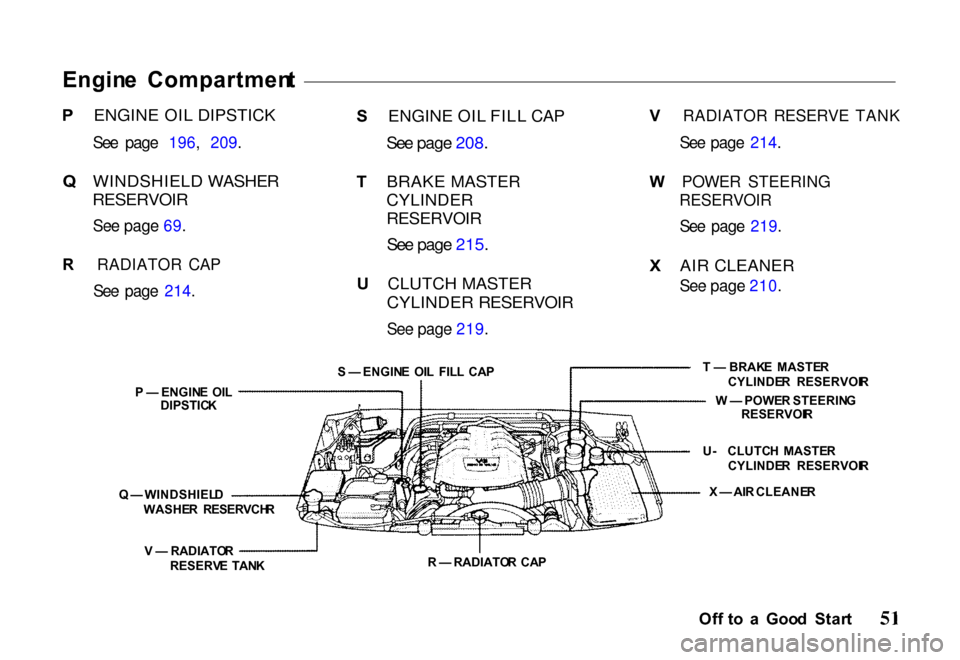
Engin
e Compartmen t
P ENGINE OIL DIPSTICK
See page 196, 209.
Q WINDSHIELD WASHER
RESERVOIR
See page 69.
R RADIATOR CAP
See page 214.
P — ENGIN E OI L
DIPSTIC K
Q — WINDSHIEL D
WASHE R RESERVCH R
V — RADIATO R
RESERV E TAN K
S
ENGINE OIL FILL CAP
See page 208.
T BRAKE MASTER
CYLINDER
RESERVOIR
See page 215.
U CLUTCH MASTER
CYLINDER RESERVOIR
See page 219. V
RADIATOR RESERVE TANK
See page 214.
W POWER STEERING
RESERVOIR
See page 219.
X AIR CLEANER
See page 210.
T — BRAK E MASTE R
CYLINDE R RESERVOI R
U - CLUTC H MASTE R
CYLINDE R RESERVOI R
R — RADIATO R CA P
Off t o a Goo d Star t
S
— ENGIN E OI L FIL L CA P
W — POWE R STEERIN G
RESERVOI R
X — AIR CLEANE R
Page 189 of 267
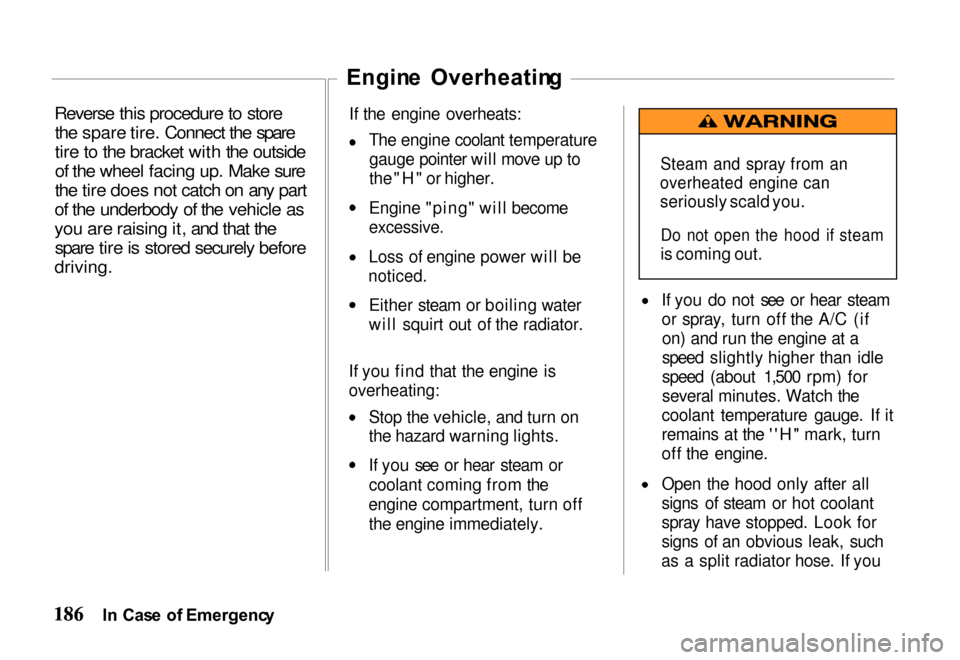
Reverse this procedure to store
the spare tire. Connect the spare
tire to the bracket with the outside
of the wheel facing up. Make sure
the tire does not catch on any part
of the underbody of the vehicle as
you are raising it, and that the spare tire is stored securely before
driving.
If the engine overheats:
The engine coolant temperaturegauge pointer will move up to
the "H" or higher. Engine "ping" will become
excessive.
Loss of engine power will be
noticed.
Either steam or boiling water
will squirt out of the radiator.
If you find that the engine is
overheating:
Stop the vehicle, and turn on
the hazard warning lights.
If you see or hear steam or
coolant coming from the
engine compartment, turn off the engine immediately. If you do not see or hear steam
or spray, turn off the A/C (if
on) and run the engine at a
speed slightly higher than idle
speed (about 1,500 rpm) for
several minutes. Watch the
coolant temperature gauge. If it
remains at the ''H" mark, turn
off the engine.
Open the hood only after all
signs of steam or hot coolant
spray have stopped. Look for
signs of an obvious leak, such
as a split radiator hose. If you
I n Cas e o f Emergenc y
Steam and spray from an
overheated engine can
seriously scald you.
Do not open the hood if steam
is coming out.
Engin
e Overheatin g
Page 190 of 267
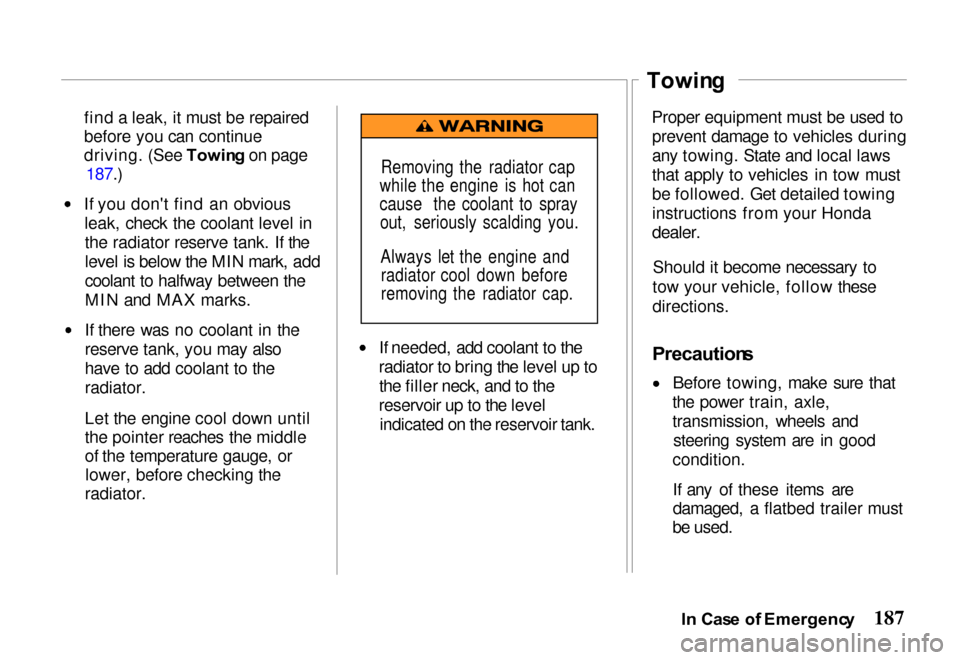
find a leak, it must be repaired
before you can continue
driving. (See
Towing on page
187.)
If you don't find an obvious leak, check the coolant level inthe radiator reserve tank. If the
level is below the MIN mark, add
coolant to halfway between the
MIN and MAX marks.
If there was no coolant in the
reserve tank, you may also
have to add coolant to the
radiator.
Let the engine cool down until
the pointer reaches the middle
of the temperature gauge, orlower, before checking the
radiator. If needed, add coolant to the
radiator to bring the level up to the filler neck, and to the
reservoir up to the level indicated on the reservoir tank. Proper equipment must be used to
prevent damage to vehicles during
any towing. State and local laws
that apply to vehicles in tow must
be followed. Get detailed towing
instructions from your Honda
dealer.
Should it become necessary to
tow your vehicle, follow these
directions.
Precaution s
Before towing, make sure that
the power train, axle,
transmission, wheels and steering system are in good
condition.
If any of these items are
damaged, a flatbed trailer must
be used.
In Cas e o f Emergenc y
Towin
g
Removing the radiator cap
while the engine is hot can
cause the coolant to spray out, seriously scalding you.
Always let the engine andradiator cool down before
removing the radiator cap.
Page 216 of 267
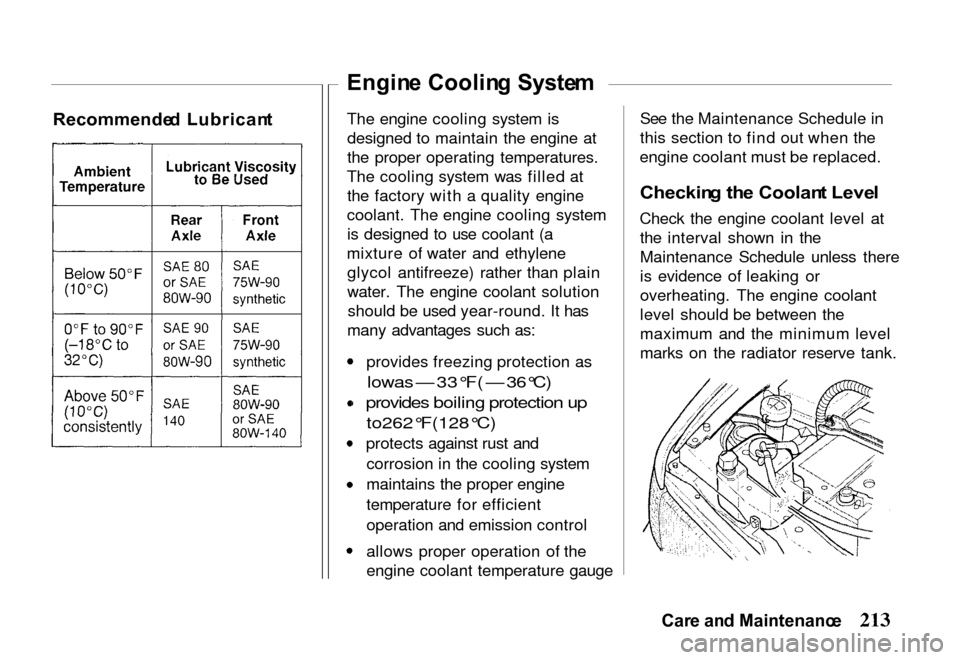
The engine cooling system is
designed to maintain the engine at
the proper operating temperatures.
The cooling system was filled at the factory with a quality engine
coolant. The engine cooling system is designed to use coolant (a
mixture of water and ethylene glycol antifreeze) rather than plain
water. The engine coolant solutionshould be used year-round. It has
many advantages such as: provides freezing protection as
lowas — 33°F( — 36°C)
provides boiling protection up
to262°F(128°C)
protects against rust and
corrosion in the cooling system maintains the proper engine
temperature for efficient
operation and emission control
allows proper operation of the
engine coolant temperature gaugeSee the Maintenance Schedule in
this section to find out when the
engine coolant must be replaced.
Checkin g th e Coolan t Leve l
Check the engine coolant level at the interval shown in the
Maintenance Schedule unless there
is evidence of leaking or
overheating. The engine coolant
level should be between the
maximum and the minimum level
marks on the radiator reserve tank.
Car e an d Maintenanc e
Recommende
d Lubrican t
Engin
e Coolin g Syste m
Page 217 of 267
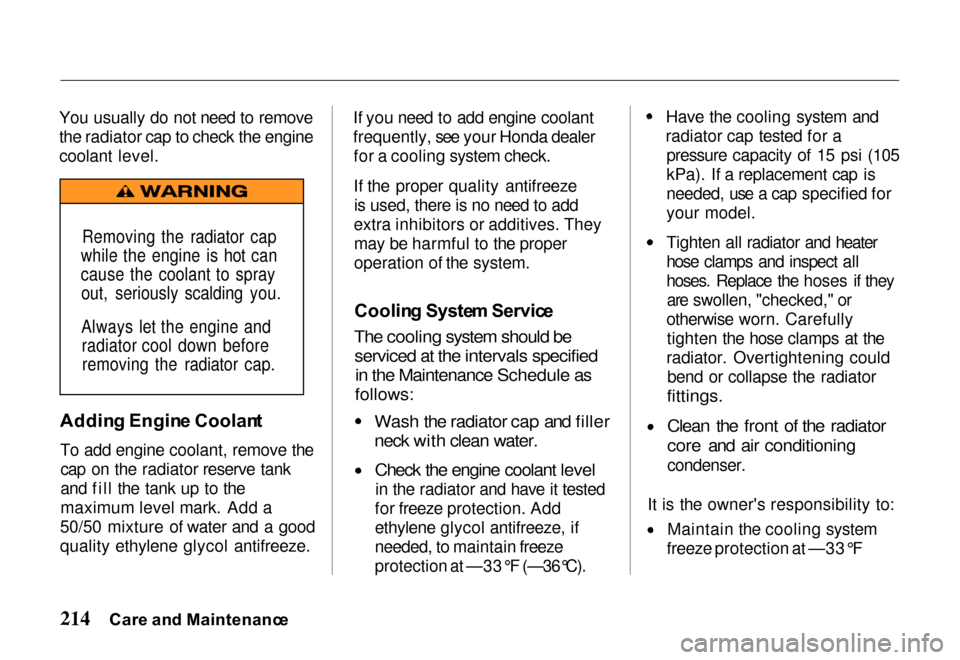
You usually do not need to remove
the radiator cap to check the engine
coolant level.
Addin g Engin e Coolan t
To add engine coolant, remove the cap on the radiator reserve tank
and fill the tank up to the
maximum level mark. Add a
50/50 mixture of water and a good
quality ethylene glycol antifreeze. If you need to add engine coolant
frequently, see your Honda dealer
for a cooling system check.
If the proper quality antifreezeis used, there is no need to add
extra inhibitors or additives. They may be harmful to the proper
operation of the system.
Coolin g Syste m Servic e
The cooling system should be serviced at the intervals specified in the Maintenance Schedule as
follows:
Wash the radiator cap and filler
neck with clean water.
Check the engine coolant level
in the radiator and have it tested
for freeze protection. Add
ethylene glycol antifreeze, if
needed, to maintain freeze
protection at —33°F (—36°C).
Have the cooling system and
radiator cap tested for a pressure capacity of 15 psi (105
kPa). If a replacement cap is
needed, use a cap specified for
your model. Tighten all radiator and heater
hose clamps and inspect all
hoses. Replace the hoses if they
are swollen, "checked," or
otherwise worn. Carefully tighten the hose clamps at the
radiator. Overtightening could bend or collapse the radiator
fittings. Clean the front of the radiator
core and air conditioning
condenser.
It is the owner's responsibility to: Maintain the cooling system
freeze protection at —33°F
Car e an d Maintenanc e
Removing the radiator cap
while the engine is hot can
cause the coolant to spray out, seriously scalding you.
Always let the engine andradiator cool down beforeremoving the radiator cap.
Page 218 of 267
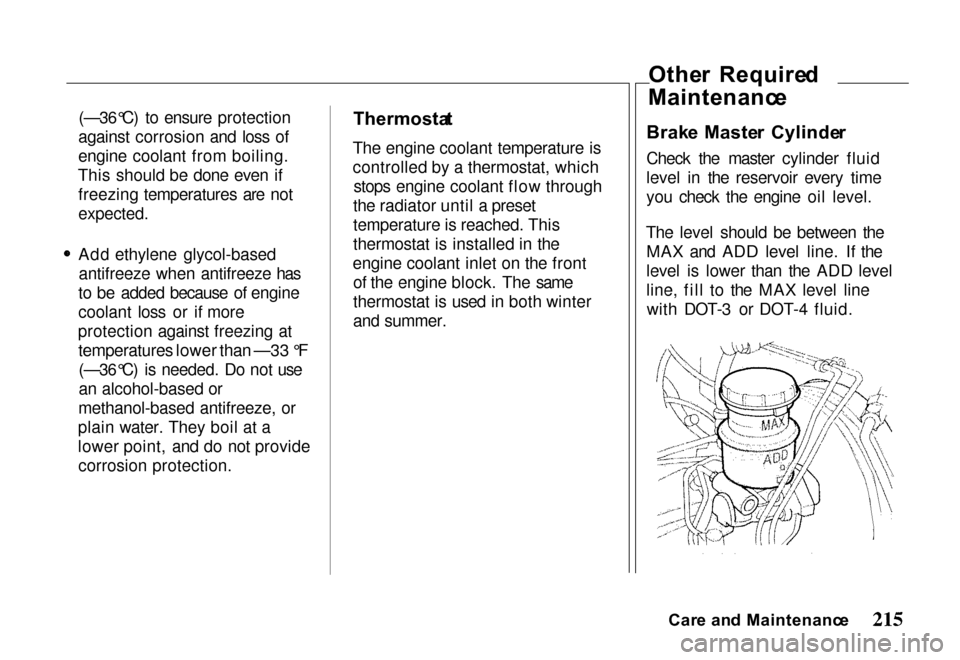
(—36°C) to ensure protection
against corrosion and loss of
engine coolant from boiling.
This should be done even if freezing temperatures are not
expected.
Add ethylene glycol-basedantifreeze when antifreeze has
to be added because of engine
coolant loss or if more
protection against freezing at
temperatures lower than —33 °F
(—36°C) is needed. Do not use
an alcohol-based or
methanol-based antifreeze, or
plain water. They boil at a
lower point, and do not provide corrosion protection.
Thermosta
t
The engine coolant temperature is
controlled by a thermostat, which stops engine coolant flow through
the radiator until a preset
temperature is reached. This
thermostat is installed in the
engine coolant inlet on the front of the engine block. The same
thermostat is used in both winter
and summer. Othe
r Require d
Maintenanc e
Brak e Maste r Cylinde r
Check the master cylinder fluid
level in the reservoir every time
you check the engine oil level.
The level should be between the MAX and ADD level line. If the
level is lower than the ADD level
line, fill to the MAX level linewith DOT-3 or DOT-4 fluid.
Car e an d Maintenanc e
Page 254 of 267
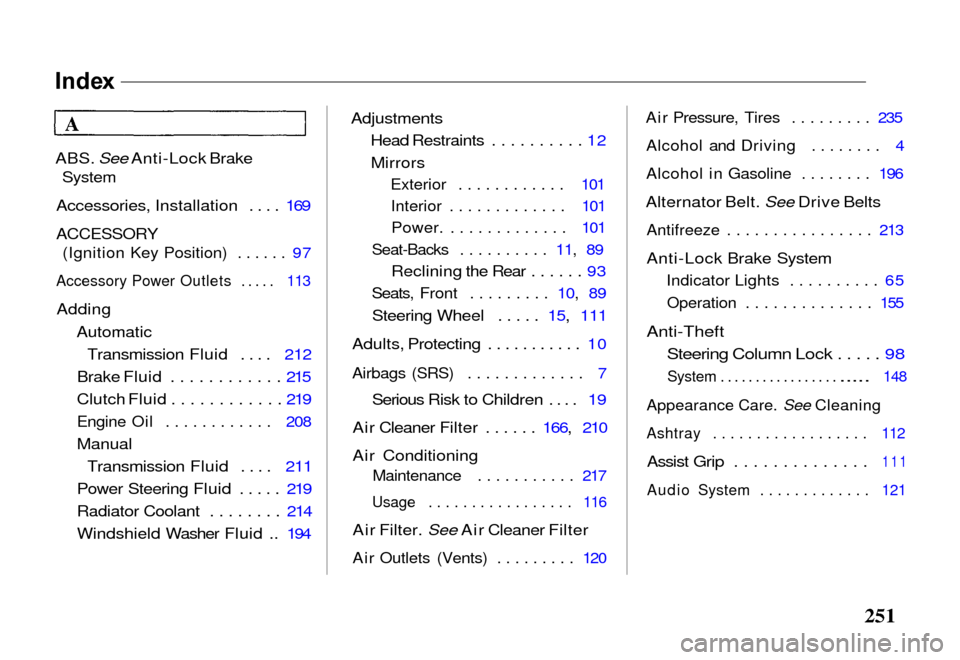
Inde
x
ABS. See Anti-Lock Brake
System
Accessories, Installation .... 169
ACCESSORY
(Ignition Key Position) ...... 97
Accessory Power Outlets ..... 113
Adding AutomaticTransmission Fluid .... 212
Brake Fluid ............ 215
Clutch Fluid ............ 219
Engine Oil ............ 208
Manual Transmission Fluid .... 211
Power Steering Fluid ..... 219
Radiator Coolant ........ 214
Windshield Washer Fluid ..
194
Adjustments
Head
Restraints .......... 12
Mirrors
Exterior ............ 101Interior ............. 101
Power. ............. 101
Seat-Backs .......... 11,
89
Reclining the Rear ...... 93
Seats, Front ......... 10,
89
Steering Wheel ..... 15,
111
Adults, Protecting ........... 10
Airbags (SRS) ............. 7
Serious Risk to Children .... 19
Air Cleaner Filter ......
166, 210
Air Conditioning
Maintenance ........... 217
Usage ................. 116
Air Filter. See Air Cleaner Filter
Air Outlets (Vents) ......... 120
Air Pressure, Tires ......... 235
Alcohol and Driving ........ 4
Alcohol in Gasoline ........ 196
Alternator Belt. See Drive Belts
Antifreeze ................ 213
Anti-Lock Brake System
Indicator Lights .......... 65
Operation .............. 155
Anti-Theft Steering Column Lock ..... 98
System .................
..... 148
Appearance Care. See Cleaning
Ashtray .................. 112
Assist Grip ..............
111
Audio System ............. 121
Page 256 of 267
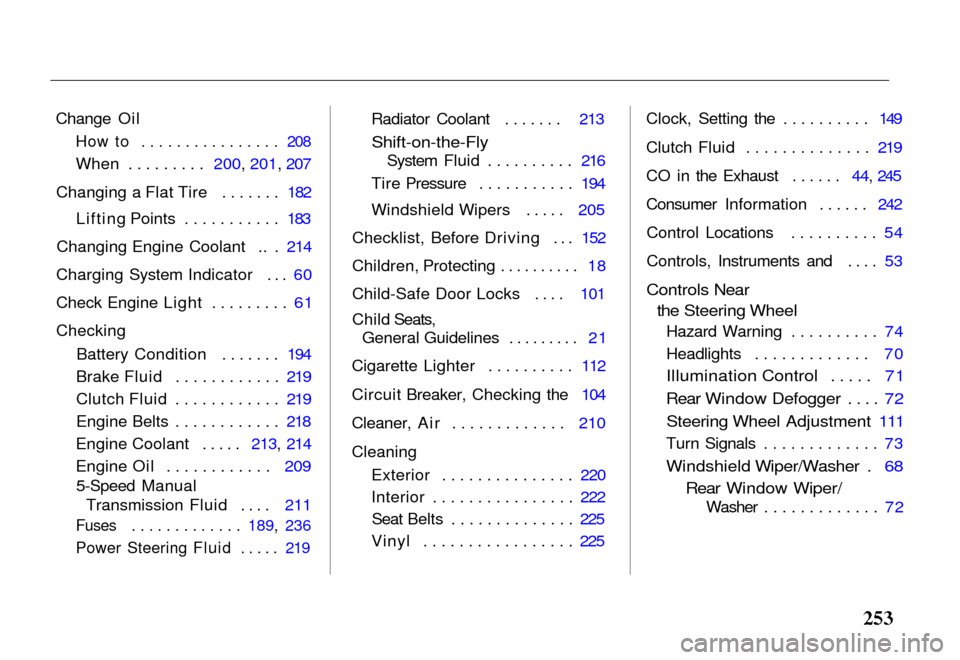
Change Oil
How to ................ 208
When ......... 200, 201, 207
Changing a Flat Tire ....... 182 Lifting Points ........... 183
Changing Engine Coolant .. . 214
Charging System Indicator ... 60
Check Engine Light ......... 61
Checking Battery Condition ....... 194
Brake Fluid ............ 219
Clutch Fluid ............ 219
Engine Belts ............ 218
Engine Coolant ..... 213, 214
Engine Oil ............ 209 5-Speed Manual Transmission Fluid .... 211
Fuses .............
189, 236
Power Steering Fluid .....
219
Radiator Coolan
t ....... 213
Shift-on-the-Fly
System Fluid .......... 216
Tire Pressure ........... 194
Windshield Wipers ..... 205
Checklist, Before Driving ... 152
Children, Protecting .......... 18
Child-Safe Door Locks .... 101
Child Seats, General Guidelines ......... 21
Cigarette Lighter .......... 112
Circuit Breaker, Checking the 104
Cleaner, Air ............. 210
Cleaning Exterior ............... 220
Interior ................ 222Seat Belts .............. 225
Vinyl ................. 225 Clock, Setting the .......... 149
Clutch Fluid .............. 219
CO in the Exhaust ......
44, 245
Consumer Information ...... 242 Control Locations .......... 54
Controls, Instruments and .... 53
Controls Near the Steering Wheel
Hazard Warning .......... 74
Headlights ............. 70
Illumination Control ..... 71
Rear Window Defogger .... 72
Steering Wheel Adjustment 111
Turn Signals ............. 73
Windshield Wiper/Washer . 68
Rear Window Wiper/
Washer ............. 72
Page 263 of 267
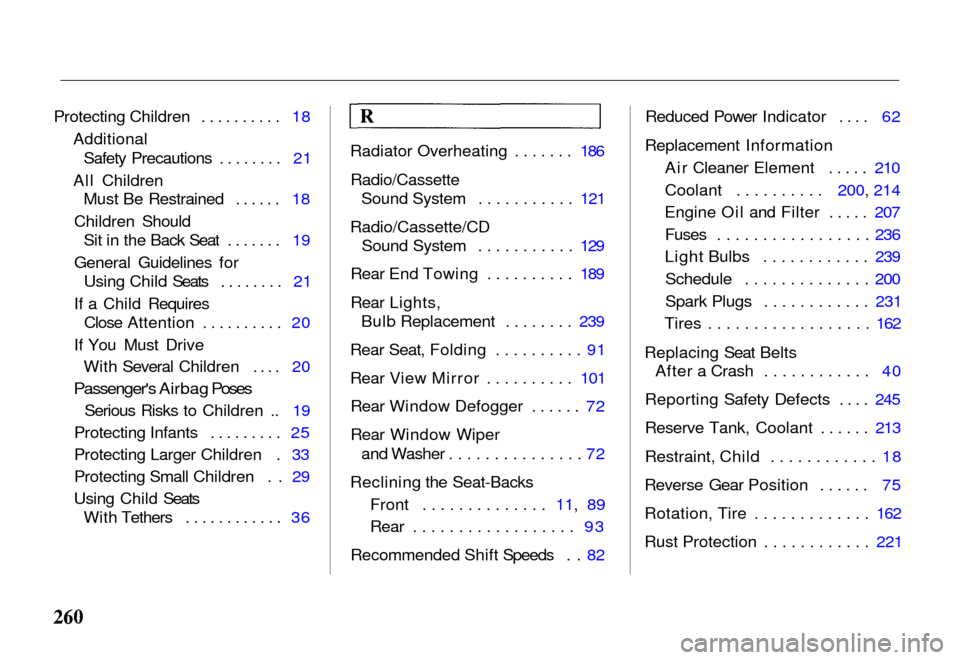
Protecting Children .......... 18
AdditionalSafety Precautions ........ 21
All Children Must Be Restrained ...... 18
Children Should Sit in the Back Seat ....... 19
General Guidelines for Using Child Seats ........ 21
If a Child Requires Close Attention .......... 20
If You Must Drive With Several Children .... 20
Passenger's Airbag Poses
Serious Risks to Children .. 19
Protecting Infants ......... 25
Protecting Larger Children . 33
Protecting Small Children . . 29
Using Child Seats With Tethers ............ 36 Radiator Overheating ....... 186
Radio/Cassette Sound System ........... 121
Radio/Cassette/CD Sound System ........... 129
Rear End Towing .......... 189
Rear Lights, Bulb Replacement ........ 239
Rear Seat, Folding .......... 91
Rear View Mirror .......... 101 Rear Window Defogger ...... 72
Rear Window Wiper and Washer ............... 72
Reclining the Seat-Backs Front .............. 11, 89
Rear .................. 93
Recommended Shift Speeds . . 82 Reduced Power Indicator .... 62
Replacement Information Air Cleaner Element ..... 210
Coolant .......... 200, 214
Engine Oi
l and Filter ..... 207
Fuses ................. 236
Light Bulbs ............ 239 Schedule .............. 200
Spark Plugs ............ 231
Tires .................. 162
Replacing Seat Belts After a Crash ............ 40
Reporting Safety Defects .... 245
Reserve Tank, Coolant ...... 213
Restraint, Child ............ 18
Reverse Gear Position ...... 75
Rotation, Tire ............. 162
Rust Protection ............ 221